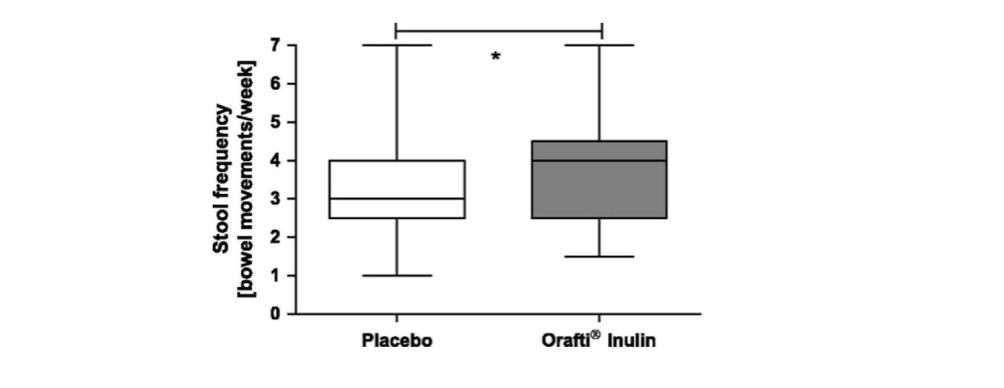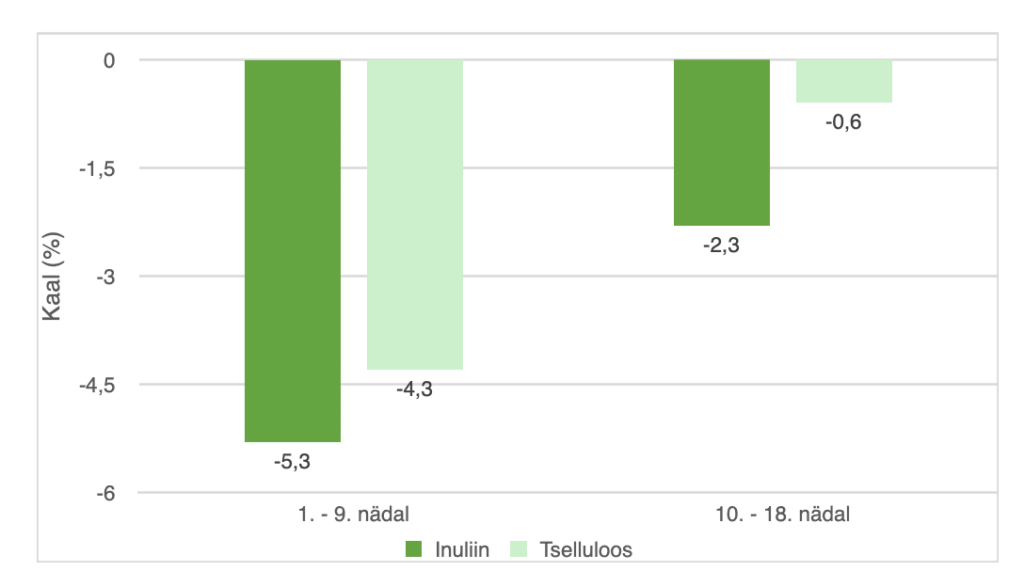
Chicory inulin – what it is and how it affects digestion?
What is an inulin?
Inulin is a soluble fiber found in many plants. Most of the inulin is in the chicory root, but it got its name from the Elecampane (Inula heleniuminstead. Chemically, it is a fructan (a polymer of fructose molecules, i.e. many fructose molecules are linked together), which helps regulate metabolism.1,2 Inulin is not broken down in the small intestine but is food for bacteria living in the large intestine. Namely, inulin acts as a prebiotic for our intestines, i.e. it promotes the growth of healthy bacteria in the intestine and promotes the restoration of the balance of the microbial community.3,4 Bacteria living in the intestine turn inulin into simple sugars during decomposition and from there into short-chain fatty acids, which nourish and protect the epithelial cells of the colon and offer various other health-promoting effects4.
Chicory inulin has a health claim officially approved by EFSA
In 2015, the European Food Safety Authority (EFSA European Food Safety Authority) issued an approved health claim for inulin extracted from native chicory (Cichorium intybus), stating that “chicory inulin contributes to normal bowel function by increasing stool frequency when consumed at 12 grams per day". The claim applies to the general population and is supported by 6 studies involving a total of 86 subjects.5
Effect of chicory inulin on the digestive system
Using chicory inulin has been shown to promote the frequency of bowel movements and reduce constipation. In fact, a four-week study* involving 44 adults with constipation found that taking 12 grams of chicory inulin per day helped soften stools and significantly increased the frequency of bowel movements compared to a control group6 (see figure 1).

Figure 1. Frequency of defecation increased in users of chicory inulin (Orafti®Inulin) compared to the placebo users (maltodextrin) (n = 44), *p = 0.038. Lower/upper edge of box = 25/75 percentile, middle line = median, whiskers = minimum/maximum level. 6
In another study, where 10 grams of chicory inulin was administered daily, the number of feces increased from an average of four to five times per week7In addition, a meta-analysis of people with chronic constipation showed that stool frequency increased, stool consistency improved, and stool hardness decreased. However, inulin had no effect on bloating and pain.8 In a study conducted on the elderly, elderly people who consumed chicory extract reported satisfaction with the digestive process and reduced problems with defecation. They did have a slight feeling of bloating, but this did not cause the subjects to stop using inulin.9
Maintaining a balance between good and bad bacteria contributes to gut health. Chicory inulin has been found to promote the growth of beneficial bacteria. Consuming chicory inulin affected the number of three genera (Bifidobacterium, Anaerostipes and Bilophila) in the intestine: he proportion of Bifidobacteriumi and Anaerostipes bacteria increased and Bilophilal decreased. Furthermore, it was observed that the reduction of Bilophila improved the problems associated with constipation.4
Thus, it can be said that the inulin-rich food extracted from chicory can increase weekly defecation frequency by supporting normal bowel movement. It can also help with problems associated with constipation. In addition, it also helps to increase fiber intake.
Inulin and weight loss
It is recommended to consume fiber because they slow down the absorption of nutrients and keep the stomach full longer. With the consumption of inulin, it has been found* that body weight, body mass index, fat percentage and waist circumference decrease10In a study with two groups, inulin consumers versus cellulose consumers, both groups lost about 5% of their body weight in the first 9 weeks. During 10-18 weeks, people who consumed inulin lost more weight.11 (see figure 2)

Figure 2. Percentage of weight loss in prediabetic patients using food supplements containing inulin or cellulose during weeks 1-1811.
Inulin and side effects
Inulin is considered a safe fiber and usually has no side effects. However, more sensitive people are advised to start with smaller doses to reduce possible side effects such as bloating and stomach discomfort.
Why is NutriDream's NutriFiber complex good?
Both NutriDream's NutriFiber complexes, pineapple and sour cherry, consist of consciously selected components with a high fiber content and good solubility.
- BENEO Orafti®GR inulin is used as inulin isolated from common chicory (Cichorium intybus). BENEO was also the first company to request a health claim from the European Food Safety Authority (EFSA) for its own inulin, which was also issued in 2015. NutriFiber complex contains 12 grams of inulin in two tablespoons of the mixture, the consumption amount of which has been approved by EFSA.
- Flax (Linum usitatissimum) seed hulls contain a lot of fiber. Flax seed consists of three parts: seed coat (spermoderm), nutritive tissue (endosperm) andcotyledon.Mucilage is predominantly present in the outer layer of flaxseed and is known to have several health benefits, such as slowing gastric emptying, lowering serum cholesterol, and improving glycemic control12Mucous substances support the protective layer in the gastrointestinal tract, which reduce irritation, promote tissue healing and also have an anti-inflammatory effect13.
- Psüllium (blond plantain, Plantago ovata) is a soluble fiber that absorbs water in the intestines. Thanks to this, it stimulates the work of the intestines, which in turn makes the removal of food residues from the body softer and more frequent. In addition, psyllium acts as a prebiotic. 14,15
- Freeze-dried pineapple (Ananas comosus) or sour cherry (Prunus Cerasus) add flavor to fiber complex mixtures. Pineapple contains significant amounts of bioactive compounds, healthy fibers, minerals and nutrients16. Sour cherries are a good source of vitamin C17.
* The study funded by BENEO (Orafti®Inulin) and/or the study participants are employees of BENEO
References:
1. Raal, A. & Vilbaste, K. Eesti Ravimtaimed III Osa. (Varrak, 2020).
2. Nwafor, I. C., Shale, K. & Achilonu, M. C. Chemical Composition and Nutritive Benefits of Chicory (Cichorium intybus) as an Ideal Complementary and/or Alternative Livestock Feed Supplement. Sci. World J. 2017, 7343928 (2017).
3. Le Bastard, Q. et al. The effects of inulin on gut microbial composition: a systematic review of evidence from human studies. Eur. J. Clin. Microbiol. Infect. Dis. Off. Publ. Eur. Soc. Clin. Microbiol. 39, 403–413 (2020).
4. Vandeputte, D. et al. Prebiotic inulin-type fructans induce specific changes in the human gut microbiota. Gut 66, 1968–1974 (2017).
5. EFSA Panel on Dietetic Products, Nutrition and Allergies (NDA). Scientific Opinion on the substantiation of a health claim related to “native chicory inulin” and maintenance of normal defecation by increasing stool frequency pursuant to Article 13.5 of Regulation (EC) No 1924/2006. EFSA J. 13, 3951 (2015).
6. Micka, A., Siepelmeyer, A., Holz, A., Theis, S. & Schön, C. Effect of consumption of chicory inulin on bowel function in healthy subjects with constipation: a randomized, double-blind, placebo-controlled trial. Int. J. Food Sci. Nutr. 68, 82–89 (2017).
7. Watson, A. W. et al. Changes in stool frequency following chicory inulin consumption, and effects on stool consistency, quality of life and composition of gut microbiota. Food Hydrocoll. 96, 688–698 (2019).
8. Collado Yurrita, L., San Mauro Martín, I., Ciudad-Cabañas, M. J., Calle-Purón, M. E. & Hernández Cabria, M. Effectiveness of inulin intake on indicators of chronic constipation; a meta-analysis of controlled randomized clinical trials. Nutr. Hosp. 30, 244–252 (2014).
9. Marteau, P. et al. Effects of chicory inulin in constipated elderly people: a double-blind controlled trial. Int. J. Food Sci. Nutr. 62, 164–170 (2011).
10. Zanzer, Y. C. & Theis, S. Systematic Review and Meta-Analysis of Chicory Inulin-Type Fructans Supplementation on Weight Management Aspects. Proceedings 91, 155 (2024).
11. Guess, N. D. et al. A randomized controlled trial: the effect of inulin on weight management and ectopic fat in subjects with prediabetes. Nutr. Metab. 12, 36 (2015).
12. Puligundla, P. & Lim, S. A Review of Extraction Techniques and Food Applications of Flaxseed Mucilage. Foods 11, 1677 (2022).
13. Raal, A., Vilbaste, K. & Sarv, M. Eesti Ravimtaimed I Osa. (Varrak, 2019).
14. McRorie, J. W. & McKeown, N. M. Understanding the Physics of Functional Fibers in the Gastrointestinal Tract: An Evidence-Based Approach to Resolving Enduring Misconceptions about Insoluble and Soluble Fiber. J. Acad. Nutr. Diet. 117, 251–264 (2017).
15. Jalanka, J. et al. The Effect of Psyllium Husk on Intestinal Microbiota in Constipated Patients and Healthy Controls. Int. J. Mol. Sci. 20, 433 (2019).
16. Mohd Ali, M., Hashim, N., Abd Aziz, S. & Lasekan, O. Pineapple (Ananas comosus): A comprehensive review of nutritional values, volatile compounds, health benefits, and potential food products. Food Res. Int. Ott. Ont 137, 109675 (2020).
17. Kelley, D. S., Adkins, Y. & Laugero, K. D. A Review of the Health Benefits of Cherries. Nutrients 10, 368 (2018).



